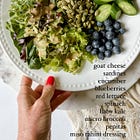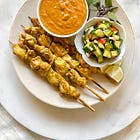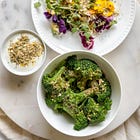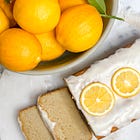is sugar evil? the truth without the hype
spoiler: it's not about the type of sugar. it's about what your body can handle.
We're bombarded with conflicting messages about sugar every day. "Sugar is poison!" "Natural sugar is fine!" "Just eat fruit instead of dessert!" “Fruit smoothies are healthy!”
But here's what I want you to know: It's not about the type of sugar. It's about what your body can handle.
Your Body Doesn't Play Favorites
Your body doesn't care whether the sugar you eat comes from raw honey from a local farm, a ripe mango, refined grains, or a candy bar. What it cares about is how much sugar it has to process at once.
All sugar—whether it's honey, fruit, fruit juice, Thai iced tea, sweet tea, lemonade, a fruit smoothie, cookies, maple syrup, bread, candy, or soda—gets broken down into the same two components: glucose and fructose. When your body is dealing with insulin resistance, pre-diabetes, diabetes, perimenopause, or menopause, this process becomes much more complicated.
Below, I address 5 common messages we’re told about sugar:
1. The "Natural" Sugar Myth
Let's address the elephant in the room: "natural" sugar is still sugar.
Honey, maple syrup, and coconut sugar might sound like better, healthier options, but chemically speaking, your body sees them the same way it sees white sugar. They still spike your blood sugar—and in some cases, even more.
Natural doesn't automatically mean better for your metabolism.
2. The Fruit Conversation
Before you panic about that apple you had for lunch, let me be clear: fruit isn't bad, but it's not a metabolic free-for-all either.
Whole fruit does contain fiber and nutrients that can help slow down blood sugar spikes slightly. But that doesn't make it sugar-free. Many fruits like bananas, grapes, and apples are particularly high in fructose, which your liver has to process.
If you're already insulin resistant, your liver may convert that excess fructose into fat rather than energy. This isn't fear-mongering—it's basic physiology.
3. The Hidden Sugar in Your "Healthy" Grains
You've cut out the obvious culprits—soda, candy, and dessert. You're choosing brown rice over white, whole grain bread over white bread, and you feel pretty good about your "low sugar" choices.
But here's what might shock you: those "healthy" whole grains are still spiking your blood sugar just like sugar does.
When you eat any grain—whether it's quinoa, brown rice, oats, whole wheat bread, or that trendy ancient grain pasta—your digestive system breaks it down into glucose. The same glucose that comes from a candy bar.
Yes, whole grains contain more fiber and nutrients than their refined counterparts, but they're still primarily starch, and starch becomes sugar in your body. Your pancreas doesn't distinguish between the glucose from your morning oatmeal and the glucose from a cookie. It just sees sugar that needs to be managed.
4. The "Whole Grain" Marketing Trap
We've been told for decades that whole grains are the foundation of a healthy diet. The food pyramid made them the biggest category for a reason, right?
But here's the uncomfortable truth: if you're dealing with insulin resistance, pre-diabetes, diabetes, PCOS, or hormonal changes in perimenopause and menopause, those "healthy" grains might be working against you.
A bowl of brown rice can raise your blood sugar just as much as—sometimes more than—a handful of jelly beans. The fiber in whole grains does slow absorption slightly, but it doesn't eliminate the glucose load your body has to process.
5. The Breakfast Revelation
Let's talk about that "healthy" breakfast many of us have been taught to eat:
Whole grain cereal with milk
Oatmeal with fruit and honey
Whole wheat toast with jam
A smoothie with oats, banana, and berries
Every single one of these meals is essentially a sugar bomb in disguise. Your blood sugar can spike, crash, and leave you reaching for more carbs to feel stable again.
A single slice of whole wheat bread can raise your blood sugar higher than a tablespoon of pure sugar or a candy bar!
The glycemic index of many whole grain foods is surprisingly high:
Brown rice: similar to white rice
Whole wheat bread: often higher than white bread
Oats: can spike blood sugar significantly- even “healthier” steel cut oats
Quinoa: still predominantly starch
Sugar Isn't the Villain
Here's something that might surprise you: your body actually needs glucose. It fuels your brain, powers your muscles, and energizes your cells. In fact, even if you never ate another gram of sugar or starch in your life, your body would make it from protein and fat. That's how important it is.
So no, sugar isn't evil. And neither are grains!
An overwhelmed metabolism is the real problem. The good news? You can improve your metabolism with the right support.
The Real Solution
If you have carbohydrate intolerance, insulin resistance, pre-diabetes, diabetes, or if you're in perimenopause or menopause, your body doesn't handle sugar and starch the same way it used to.
Instead of efficiently using glucose for energy, it builds up in your blood. That's when sugar and starchy foods shift from fuel to problems.
That said, you don't need to fear food!
Understanding your body's unique response to different foods—including sugar and grains—is far more valuable than following generic rules about "good" and "bad" foods.
The goal isn't to eliminate sugar and grains entirely. It's to understand how your metabolism works right now and make choices that support rather than overwhelm it.
Here's what actually works:
Build meals around protein, healthy fats, and non-starchy vegetables first
If you choose to include grains or natural sugars, pair them strategically with protein and fat to minimize blood sugar impact
Learn to read your body's signals and adjust accordingly
Focus on supporting your metabolism
When your metabolism is functioning well, you can enjoy life's sweetness—literally and figuratively—without the guilt or the glucose spikes.
So, What's Next?
If you're ready to dive deeper into understanding your unique metabolism, I've created a comprehensive resource that guides you through everything I've learned about blood sugar balance. The Blood Sugar Method brings together the strategies I use with my private clients—from meal planning and movement to navigating hormonal changes—all in a self-paced format.
This isn't about quick fixes or restrictive diets. It's about understanding your body's signals and building sustainable habits that support your long-term health. Because when you understand how your metabolism works, you can make informed choices that actually serve your body.
Our next group detox is a month away! Join us July 7-14 - find all of the details here:
All of my best coupons are newly updated:
Matcha single serve packets- I traveled with these all through Thailand recently, and they were such a convenient way to enjoy my morning matcha in my hotel room by just adding hot water!
My frother just gave up the ghost, so I replaced it with this one. It is hands down the best one I have tried! I love that it has a power button on the end, and it's extremely powerful!
Collagen and creatine are my favorite tea and matcha add-ins. My favorites are on Fullscript and always 20% off!
Together, we're building a community focused on real food and metabolic health. If you enjoyed this post, please “like” and “restack” to help others find their way to better health, too!
Thank you for being here,























I love this message! Beth, you work so hard to bring us great information, thank you! 🙏
Such a refreshing take, Beth. Balanced, practical, and rooted in understanding rather than fear. I really appreciated how you explained that it's not about demonizing sugar, but about knowing how our bodies process it. Feels empowering, not punishing.